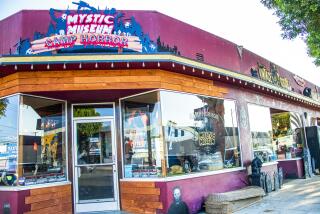How a Treasure of Desert History Turned Into Nothing but Fool’s Gold
It was New Year’s Eve when Jerry Freeman phoned LeRoy Johnson to tell him about his amazing discovery in the back country of Death Valley National Park: a chest of possessions abandoned 150 years ago by a luckless forty-niner.
Johnson, a friend of Freeman’s and an authority on Death Valley history, hopped into his car and drove more than 200 miles from Bishop to Freeman’s Pearblossom home to see for himself.
“I was just astounded at it,” Johnson recalled last week. “I took it at face value. Then when we began looking at individual things, I began raising questions to Jerry. Still, it seemed credible.”
But as he drove home the next day, Johnson developed more reservations. Some of the chest contents just didn’t make sense. In San Diego, Richard Lingenfelter, another Death Valley historian, had the same reaction when he read a newspaper account.
Although it would take several weeks of historical detective work before the National Park Service pronounced the chest a fake, the discovery almost instantly raised doubts among Death Valley cognoscenti.
The small wooden trunk contained what Lingenfelter called a “curious collection of belongings”: bowls, a doll, a flintlock pistol, a pair of child’s shoes, gold and silver coins, lace, tintypes, a telescope, a hymnal with a short, emotional letter tucked inside, and a manifest of the chest’s contents dated Jan. 2, 1850.
The manifest bore the name of William Robinson, one of the pioneers who in 1849 took a misguided shortcut through Death Valley on their way to the California gold fields. The letter, signed “William,” was an eloquent if ungrammatical farewell by a man uncertain of his fate. His last ox had died, forcing him to leave the chest behind and continue on foot.
Did it make sense, Lingenfelter mused, for someone headed for the gold fields to leave behind coins that easily could have been carried in his pocket? The telescope was broken. Why, wondered Johnson, would a man struggling through some of the harshest country in America lug along a busted telescope?
Lingenfelter’s suspicions were further raised by the manifest, which referred to a “grubstake,” a form of prospector credit. The earliest recorded mention of the term dates from 1863, Lingenfelter said, and the practice probably didn’t develop until the late 1850s.
Lingenfelter, the author of a 1986 book on Death Valley’s history and myth, called the park service with his doubts. Johnson too talked to the park staff and in mid-January, after Freeman had turned the chest over to the park officials, drove to Death Valley to once again examine it.
The park service brought in an expert from the Western Archeological and Conservation Center in Tucson and consulted other historians. They scrutinized the trunk’s contents through the lens of science, history and common sense.
The letter, written in pencil, contained erasures. When you’re hungry, thirsty and scribbling what may be your final words, are you really going to be fumbling around with an eraser?
The manifest and letter appeared to be written on old paper, but they looked very much to Johnson as if they had been ripped from the back of an old book.
Then there was the fact that many of the items were in remarkably good shape. True, the dry climate would preserve artifacts. But, said park spokesman Tim Stone, “the overall condition of the trunk and artifacts just appeared not to match something that had been outside in this environment” for a century and a half.
Still, such speculation was just that, not definitive proof. For that the park service conservator turned to various items in the chest.
One was a ceramic bowl with a manufacturer’s name and mark on the bottom. Park staff contacted the National Museum of American History at the Smithsonian Institution, which has records of manufacturing hallmarks.
Museum ceramics expert Bonnie Lilienfeld looked up the mark--a shield with two horizontal lines and a crown. The German company that made the bowl didn’t start using that mark until 1914.
Glue on a few items didn’t look like the heavy adhesive of the 1800s, so the conservator took some samples to Tucson for testing. They contained 20th century polymers.
Finally, there were two tintypes. A reference check confirmed that the photographic process used for tintypes wasn’t patented until 1856.
“Nothing in that box was placed there by one of the forty-niners. Nothing,” emphasized Johnson, who with his wife, Jean, wrote a book about William Manly’s rescue of the forty-niners stranded in Death Valley during the winter of 1849-50.
“If it had been real, it would have been one of the greatest contributions to Death Valley historical artifacts that you can imagine,” Johnson added. “But it’s not real.”
That is a painful thing for Johnson to say about his friend’s discovery. “I have no reason to believe Jerry perpetrated a hoax,” he said. “I’m not willing to point fingers at Jerry or anyone else.”
Freeman, a substitute teacher long fascinated with the Death Valley forty-niners, remains adamant that the chest is genuine.
“I stand by the authenticity of that trunk,” Freeman said Friday. “My feelings are [that] any conclusions the park service draws are at best suspect and probably bogus.”
If it is a hoax, he said, “it was a setup, and I’m the fall guy.”
The matter will be turned over to the Interior Department’s West Coast solicitor’s office, Stone said, but it is unclear if any legal action will be taken. The park is not sure what to do with the chest. One idea is to display it--as a grand example of Death Valley fakery.
More to Read
Sign up for Essential California
The most important California stories and recommendations in your inbox every morning.
You may occasionally receive promotional content from the Los Angeles Times.











